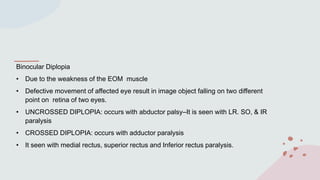Diplopia, or double vision, occurs when a person sees two images of a single object simultaneously. It can be caused by issues with eye muscles, nerves, or eye alignment. Diplopia can affect one or both eyes. When it affects both eyes, it is usually due to a neurological problem that causes the images from each eye to not match up properly. Common causes of monocular diplopia include dry eyes, lens issues, or retinal problems. Binocular diplopia is often due to weakness of eye movement muscles. Doctors evaluate the nature and causes of diplopia through tests of eye movement and alignment.














